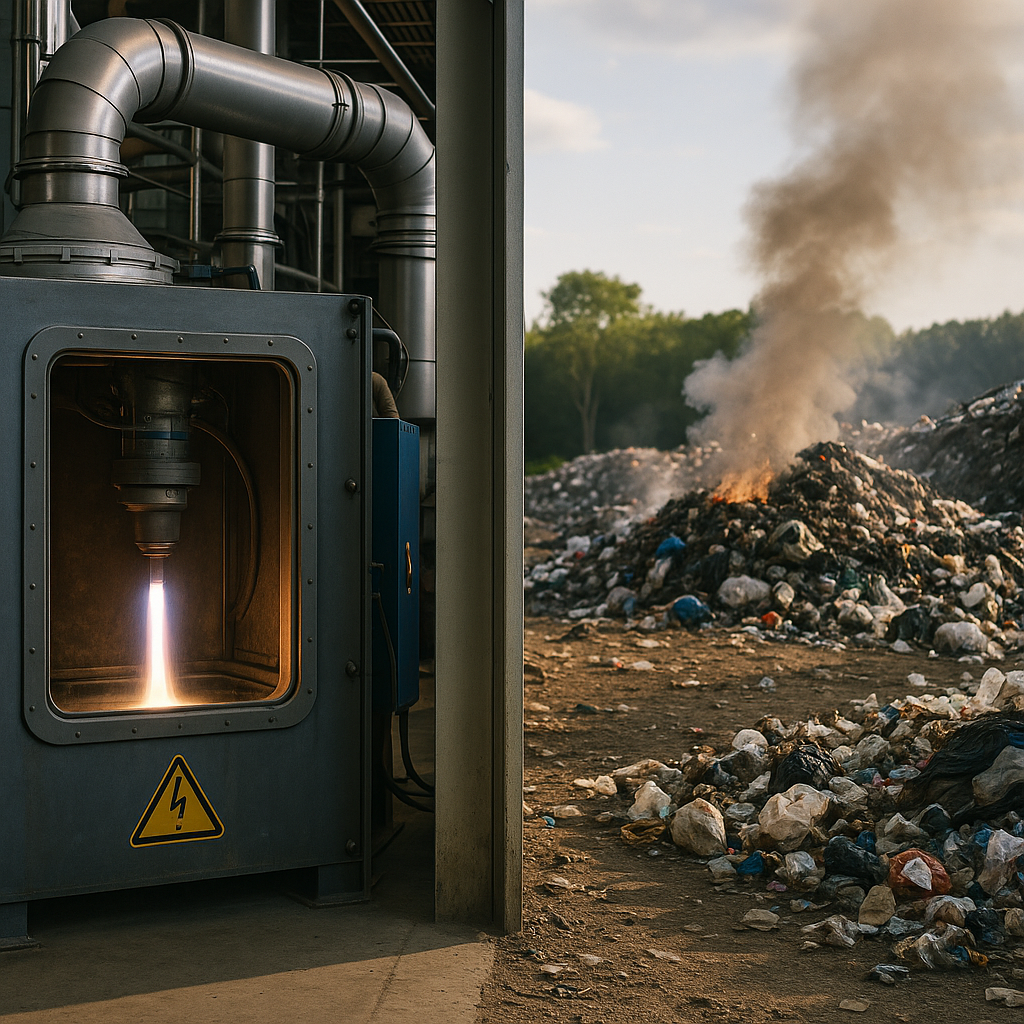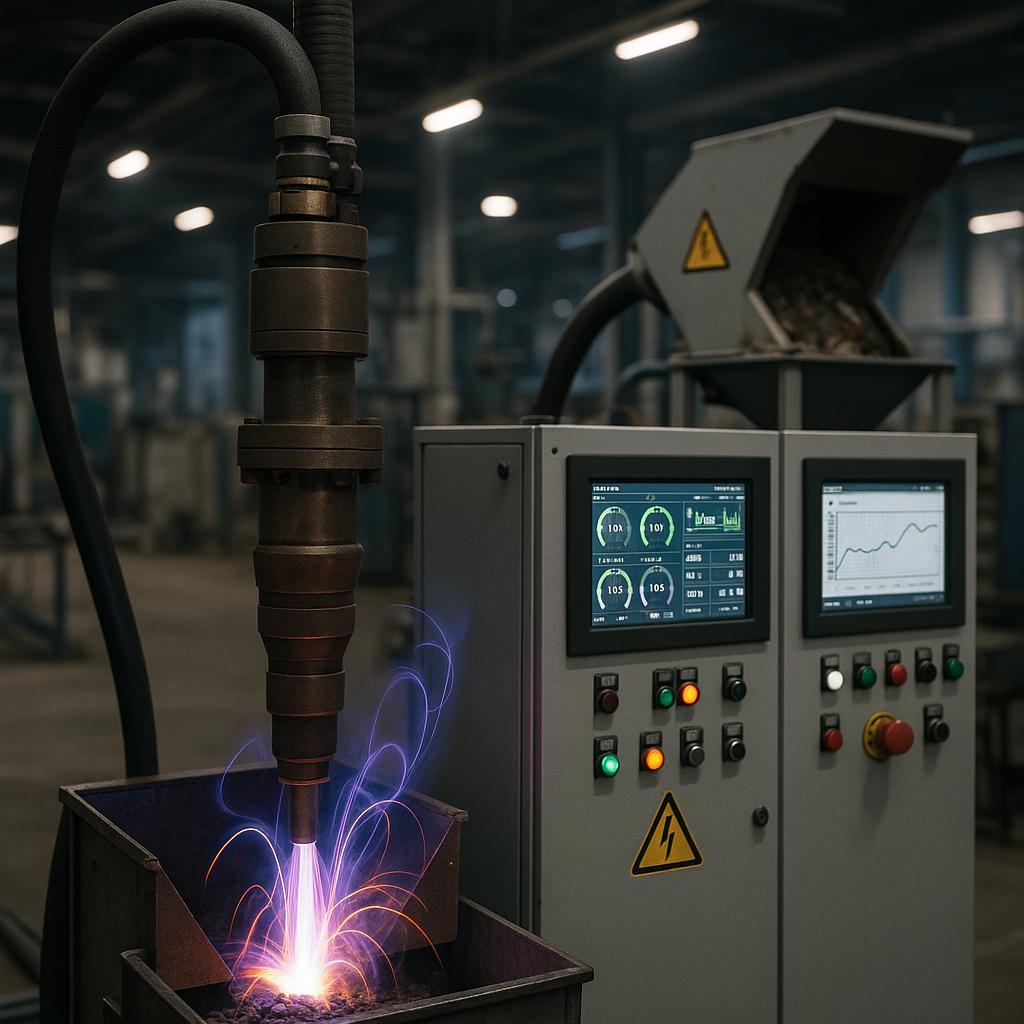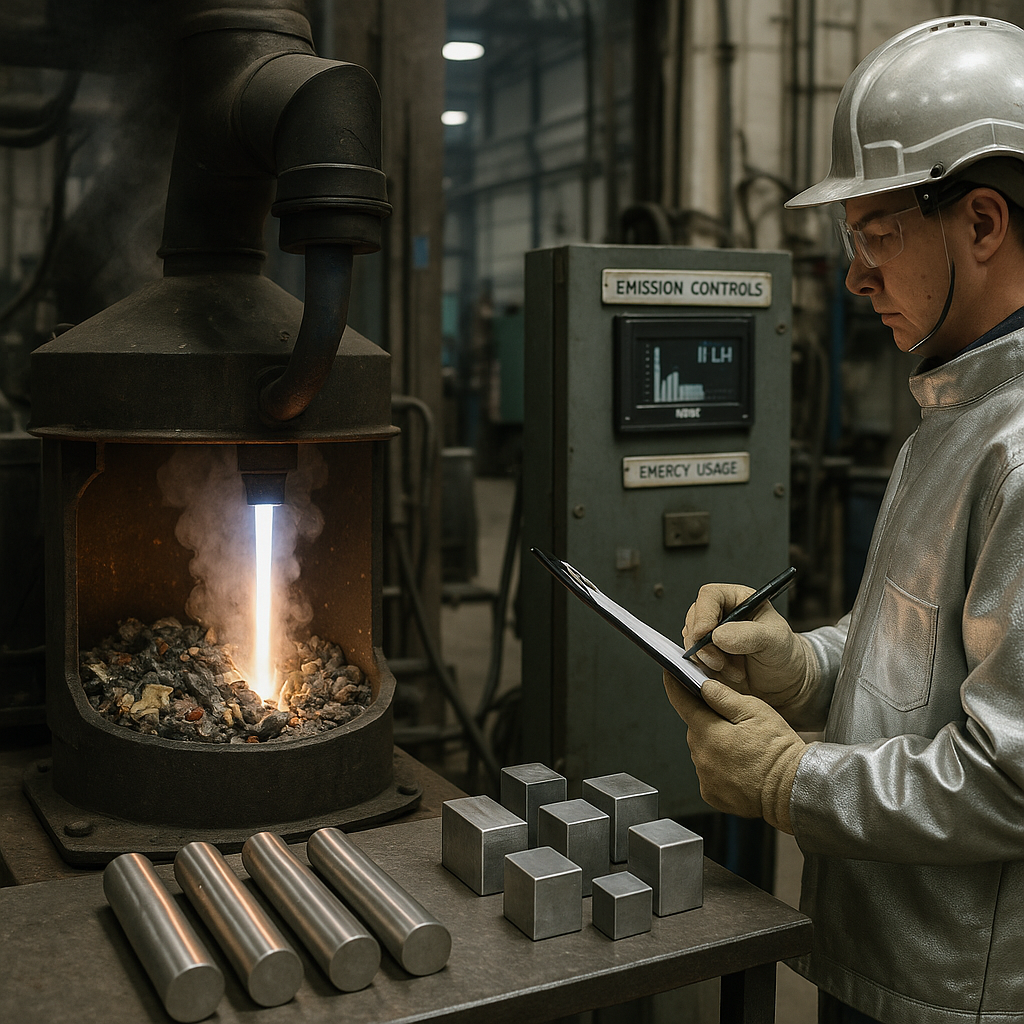5901 Botham Jean Blvd, Dallas, TX 75215
Plasma Arc Recycling Process: How It Works, Benefits, and Future of Waste Management
September 30, 2025Imagine a technology so powerful it can convert garbage into clean energy and useful materials. Plasma arc recycling achieves precisely that. This advanced waste treatment method uses extremely high temperatures—ranging from 1,000°C to 15,000°C—to break down waste materials into their basic elements without combustion.
At the core of this technology is the plasma arc torch. This device creates an electrical spark similar to lightning but in a controlled environment. When gas passes through this electrical arc, it creates plasma—an extremely hot state of matter that vaporizes waste instantly. Unlike traditional incineration, which burns waste at a few hundred degrees, plasma technology operates in an oxygen-starved environment, preventing combustion and resulting in significantly cleaner outputs.
The process transforms waste into two primary byproducts: syngas and slag. Syngas, a mixture primarily of hydrogen and carbon monoxide, can be captured and used as fuel for electricity generation. The remaining inorganic materials cool and solidify into a glass-like substance called slag, which can be repurposed as construction aggregate for roads and buildings. This process effectively diverts up to 98% of waste from landfills.
How Does Plasma Arc Recycling Differ From Other Waste Treatment Methods?

Unlike incineration, which burns waste with oxygen at several hundred degrees, plasma arc recycling breaks down waste in an oxygen-starved environment at temperatures reaching up to 10,000°C. This difference fundamentally changes how waste is processed and what remains afterward.
Traditional incineration relies on combustion, where waste materials are burned in the presence of oxygen, creating ash residue and releasing flue gases containing pollutants like dioxins, furans, and heavy metals. These emissions require extensive scrubbing to meet environmental standards, and the process still produces bottom ash that requires safe disposal.
Plasma arc technology, by contrast, uses electricity to create an intensely hot plasma field that doesn’t burn waste but breaks it down to its elemental components. The extreme heat separates waste into its basic elements in an oxygen-starved environment, preventing many harmful compounds typically associated with combustion.
Material Versatility
Plasma arc recycling can handle a significantly wider range of materials than conventional waste treatment methods. While traditional recycling struggles with complex or mixed materials, plasma systems can process everything from municipal solid waste to hazardous substances.
Electronic waste containing circuit boards, batteries, and toxic components that cannot be easily processed through conventional recycling finds an effective treatment path through plasma systems. Similarly, medical waste requiring secure destruction can be safely processed, breaking down pathogens and hazardous components.
Even materials previously considered problematic for waste management—such as asbestos, chemical weapons, or incinerator ash—can be effectively treated through plasma technology, with dangerous compounds neutralized by the extreme heat.
Superior Byproducts
The outputs from plasma arc recycling offer substantial advantages over traditional waste treatment methods. Instead of creating harmful emissions and ash requiring disposal, plasma systems produce two primary byproducts: syngas and vitrified slag.
Syngas, mainly a mixture of hydrogen and carbon monoxide, serves as a valuable fuel source. This gas can be captured and used to generate electricity through gas turbines or reciprocating engines, creating a closed-loop energy system. In many cases, plasma facilities can become net energy producers, generating more electricity than they consume in operation.
The inorganic components of waste are transformed into a glass-like substance called slag. This vitrified material safely encapsulates any remaining heavy metals, preventing leaching. Unlike incinerator ash, which often contains toxic components requiring careful disposal, slag can be used as construction aggregate for roads or building materials.
Environmental performance comparisons between plasma arc technology and incineration show striking differences. Research indicates plasma systems produce significantly fewer acidic gases, virtually eliminate ash production, and achieve up to 95% waste volume reduction compared to incineration’s 90%.
| Criteria | Incineration | Plasma Arc Recycling |
|---|---|---|
| Environment | Combustion-based, emits ash and pollutants like dioxins, requires extensive scrubbing | Breaks down waste to elements without combustion, fewer pollutants, produces syngas and slag |
| Temperature | Several hundred degrees Celsius | Up to 10,000°C |
| Byproducts | Ash, flue gas | Syngas, slag |
| Volume Reduction | 90% | Up to 95% |
| Material Handling | Limited to certain types of waste | Handles diverse waste including hazardous materials |
| Energy Recovery | Can generate electricity from heat | Generates electricity from syngas; potential for net energy production |
| Capital Costs | Lower initial investment | Higher initial investment but valuable byproducts |
While plasma arc technology requires a higher initial capital investment than conventional incineration, its environmental benefits, its ability to process previously untreatable wastes, and its valuable byproducts make it an increasingly attractive option for comprehensive waste management solutions. As regulations on emissions grow stricter and landfill space becomes scarcer, plasma technology represents a forward-looking approach to waste management that addresses both energy needs and environmental concerns.
What are the main components of a plasma arc recycling system?

A plasma arc recycling system consists of several critical components working together to transform waste into usable byproducts through high-temperature processing. Let’s examine each of these essential components in detail.
Waste Feed System
The waste feed system initiates the recycling process. It typically includes a hopper and conveyor mechanism to introduce waste materials into the reactor vessel. Modern systems handle various waste types, from municipal solid waste to hazardous materials, with minimal pre-sorting. The feeding rate is carefully controlled to maintain optimal conditions within the reactor.
Plasma Torch
The plasma torch is the system’s heat source, generating temperatures over 3,000°C by creating an electrical arc between electrodes. This superhot ionized gas (plasma) breaks down waste into its basic molecular components. Two main types of plasma torches are used: transferred torches, where the arc forms between the torch and a conductive material, and non-transferred torches, where the arc forms entirely within the torch.
Reactor Vessel
The reactor vessel is the chamber where waste encounters the plasma’s extreme heat. Built with refractory materials to withstand intense temperatures, it provides a controlled environment for gasification. Organic materials convert to syngas while inorganic materials melt to form slag. Some advanced systems use a centrifugal design to enhance efficiency and slag separation.
Gas Cleaning System
Once syngas is produced, it must be cleaned before use. The gas cleaning system removes particulates, heavy metals, and other contaminants through processes like quenching, scrubbing, and filtration. Components may include cyclones, baghouse filters, wet scrubbers, and carbon injection systems to meet environmental regulations for emissions control.
Energy Recovery Unit
The energy recovery unit captures and utilizes the energy content of the produced syngas. This unit typically consists of either a waste heat boiler generating steam for electricity production or a combustion turbine system for efficient power generation. Advanced facilities may use combined cycle systems to maximize energy recovery efficiency. The clean syngas, mainly hydrogen and carbon monoxide, serves as a valuable fuel source.
During operation, waste materials enter through the feed system into the reactor, where the plasma torch breaks them down into syngas and molten inorganic materials. Syngas exits the reactor to the gas cleaning system, while molten materials form a liquid pool that solidifies into glassy, non-leachable slag upon cooling, often repurposed as construction material.
This integrated system provides an environmentally sound method for waste processing, minimizing landfill demands while recovering valuable energy and materials from waste streams that are difficult to process conventionally.
What are the advantages and limitations of plasma arc recycling?
Advantages of Plasma Arc Recycling
Plasma arc recycling can effectively treat a wide range of waste materials, including those difficult to process through conventional methods. Complex or mixed materials that resist traditional recycling approaches, such as electronic circuit boards, can be efficiently broken down using plasma technology.
A significant benefit is the production of valuable byproducts. The process generates syngas, a mixture of hydrogen and carbon monoxide that can be used like natural gas to produce electricity, partially offsetting operational costs.
The solid byproduct known as slag resembles obsidian and can be repurposed into construction materials. This versatile material can be used as artificial gravel, bricks, and other building components, transforming waste into valuable resources.
Unlike incineration, plasma arc technology doesn’t burn waste but breaks it down to its basic elements in an oxygen-starved environment. This fundamental difference means the process doesn’t produce ash or the harmful emissions typically associated with combustion-based waste management.
The technology significantly reduces landfill dependence. By converting waste into usable byproducts rather than buried material, plasma arc recycling addresses a critical waste management challenge faced by municipalities today.
Limitations of Plasma Arc Technology
The high cost of plasma arc systems remains a major barrier to widespread adoption. The initial capital investment and ongoing operational expenses often surpass those of conventional waste management methods.
The technology itself is complex. Implementing and maintaining plasma arc systems requires specialized expertise and training, which might not be readily available in all regions or organizations.
While it produces fewer harmful emissions than incineration, plasma arc recycling is not completely emission-free. The process generates gaseous byproducts that must be cleaned before being released into the atmosphere, adding complexity and cost.
Energy requirements pose another significant challenge. The plasma torch requires substantial electrical input to reach the extremely high temperatures necessary for the process—often exceeding 28,000°C. This energy demand affects both operational costs and the environmental footprint.
Additional concerns include noise and radiation produced by plasma torches, requiring appropriate safety measures and potentially limiting facility locations.
Conclusion: The Future of Plasma Arc Recycling in Waste Management

Plasma arc recycling is a leading-edge technology in waste management, offering impressive capabilities for treating a wide range of hazardous materials that conventional methods struggle to process safely. Its ability to break down complex waste into valuable syngas and inert slag highlights its potential as a cornerstone of waste management systems that emphasize resource recovery over mere disposal.
Despite its technical advantages, plasma arc recycling faces significant challenges in market adoption. The high capital costs of establishing plasma facilities and their substantial energy requirements currently limit widespread implementation. Competition from less expensive, though often less environmentally sound alternatives, continues to dominate the waste management landscape. Additionally, the technology requires specialized expertise for operation and maintenance, creating barriers to entry for many potential adopters.
Looking ahead, the future of plasma arc recycling will likely depend on several factors. Technological advancements that increase energy efficiency and reduce operational costs will be crucial for improving economic viability. Regulatory frameworks recognizing the environmental benefits of plasma processing and potentially restricting less sustainable methods could significantly influence adoption rates. As global sustainability goals become more pressing and waste volumes continue to increase, the value proposition of plasma arc technology may become increasingly compelling.
For municipalities and businesses seeking effective solutions for their most challenging waste streams, contact Okon Recycling at 214-717-4083. Our team can help you evaluate whether plasma arc or other recycling technologies best suit your specific waste management needs.
